
The Honda Prelude is a sports car produced by the Japanese company Honda over five generations from 1978 to 2001.

The Honda CB750 is an air-cooled, transverse, in-line-four-cylinder-engine motorcycle made by Honda over several generations for year models 1969–2008 with an upright, or standard, riding posture. It is often called the original Universal Japanese Motorcycle (UJM) and also is regarded as the first motorcycle to be called a "superbike".

The Northstar engine is a family of high-performance 90° V engines produced by General Motors between 1993 and 2011. Regarded as GM's most technically complex engine, the original double overhead cam, four valve per cylinder, aluminum block/aluminum head V8 design was developed by Oldsmobile R&D, but is most associated with Cadillac's Northstar series.

The Honda CX series motorcycles, including the GL500 and GL650 Silver Wing variants, were developed and released by Honda in the late 1970s, with production ending in most markets by the mid 1980s. The design included innovative features and technologies that were uncommon or unused at the time such as liquid cooling, electric-only starting, low-maintenance shaft drive, modular wheels, and dual CV-type carburetors that were tuned for reduced emissions. The electronic ignition system was separate from the rest of the electrical system, but the motorcycle could only be started via the start button.
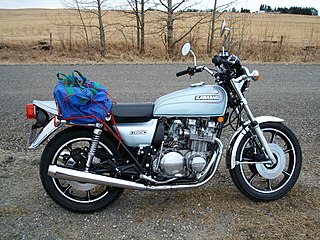
The Kawasaki Z650 was produced as a 652 cc (39.8 cu in) standard motorcycle by Kawasaki from 1976 until 1983. It had a four-cylinder four-stroke, DOHC, air-cooled, wet sump engine positioned across the frame with two valves per cylinder and a five-speed gearbox. Designed as a middleweight version of the Kawasaki Z900, the similar-styling had "an attenuated version of the traditional Kawasaki tail fairing". It competed in the market against the smaller SOHC Honda CB650. The Z650 was the epitome of the "Universal Japanese Motorcycle" (UJM).
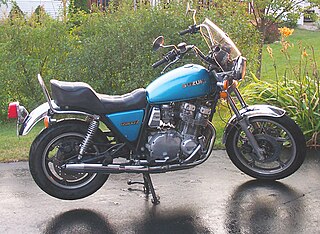
The Suzuki GS series was Suzuki Motor Corporation's first full range of 4-stroke powered road motorcycles, having previously almost exclusively manufactured 2-stroke machines. Suzuki had produced the 4-stroke Colleda COX 125cc and 93cc 4-stroke single-cylinder machines in 1955 however the rest of Suzuki's production from 1952 to 1976 had been increasingly sophisticated two-stroke road machines, whose ultimate expression was the 750cc 3-cylinder water-cooled GT750.
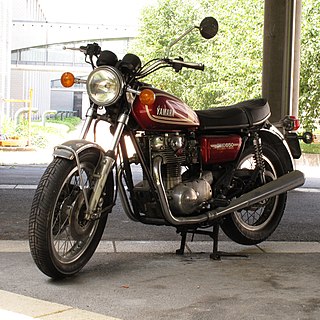
The Yamaha XS650 is a mid-size motorcycle that was made by the Yamaha Motor Company. The standard model was introduced in October 1969, and produced until 1979. The "Special" cruiser model was introduced in 1978 and produced until 1985. The XS650 began with the 1955 Hosk SOHC 500 twin. After about 10 years of producing 500 twin, Hosk engineers designed a 650 cc twin. Later Showa Corporation acquired the Hosk company, and in 1960 Yamaha acquired Showa, with Hosk's early design of 650 cc twin.
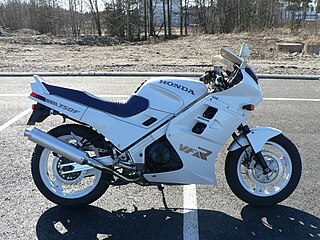
The Honda VFR750F is a motorcycle manufactured by Japanese automobile manufacturer Honda from 1986 to 1997. The motorcycle is a very sporty sport tourer, and is powered by a 750 cc (46 cu in) V4 engine developed from the earlier VF750F models. The VFR was announced in 1986, after an initial press viewing at the 1985 Bol d'Or.
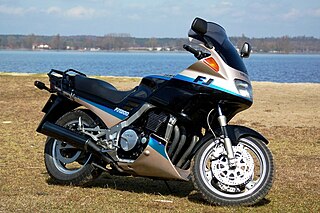
The Yamaha FJ1100 and FJ1200 are sport touring motorcycles that were produced by Yamaha between 1984 and 1996.

The Honda RVF750R RC45 was a fully faired racing motorcycle created for homologation purposes for the Superbike World Championship by Honda Racing Corporation. The RVF750R was the successor to the VFR750R RC30. Like its predecessor, the RVF750R featured a DOHC liquid-cooled V4 4-stroke engine with gear driven cams and a single-sided swingarm, but unlike the RC30 it utilized electronic fuel injection, in a setup very similar to the production 1992 NR750. The US spec engine had a 749.2cc capacity and was rated at 101 horsepower; the European version was rated at 118 horsepower. A simple rewire modification to the PGM-FI box increased power in the US engine up to the 118 hp. It was manufactured from 1994 until 1995 and sold in limited numbers, followed by the VTR1000R SP-1 RC51 in 2000. Unlike the VFR750R RC30 and VFR750F from which the engine was originally derived the gear drive for the cams was moved from the centre of the engine in between the cylinders to the one side allowing a slightly narrower engine.
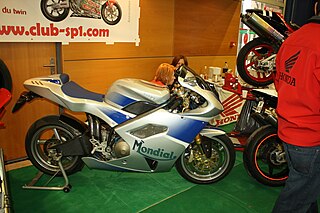
The Mondial Piega 1000 is an exotic, limited production Italian sport bike made by Mondial. The engine is from Honda, the same V-twin used on the VTR-1000 SP-1.

Formula 1000 (F1000) is a class of open wheel formula racing with professional and amateur series worldwide. Formula 1000 gets its name from the 1000 cc super-bike engine used to power a single seat, open wheel race car with fully adjustable wings and suspension.
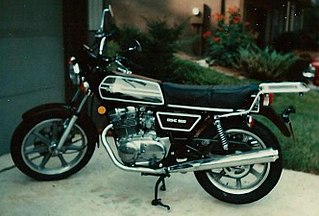
The Yamaha TX500 is a two-cylinder standard motorcycle built by Yamaha and sold in 1973 and 1974. Early models closely resembled the Triumph Bonneville in style. In 1975 the bike was renamed XS500 and then continued to be updated until 1978 when sales ended in the USA. In Europe, the model was available through 1980.
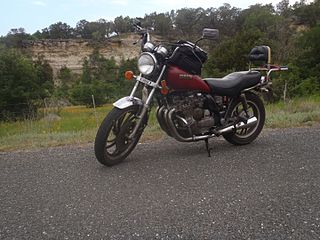
The Yamaha XJ650 Maxim is a mid-size motorcycle by the Yamaha Motor Company introduced in 1980 as the Maxim I and produced through 1983. Yamaha designed the high-performance XJ650 as a brand-new four-cylinder with shaft drive, and built it specifically as a special cruiser. The XJ Maxim was the successor of the XS Special introduced in 1978.

The Honda CB400 Super Four is a CB series 399 cc (24.3 cu in) standard motorcycle produced by Honda at the Kumamoto plant from 1992 to the present. The CB400 embodies the typical Universal Japanese Motorcycle produced through the 1970s, updated with modern technology. To this end, the bike has a naked retro design, paired with a smooth inline-four engine. Originally a Japan-only bike, it was later also available in SE Asia, and from 2008 in Australia.

The Ducati 450 R/T (road/trail) is a 436 cc (26.6 cu in) single cylinder bevel drive desmodromic SOHC motorcycle produced by the Italian manufacturer Ducati from 1971 to 1974. Initially produced at the request of the American importers Berliner Motor Corporation as a motocross / enduro motorcycle offered exclusively to the American market, and only a few hundred machines were made of this type. It is the only off-road racing motorcycle to use desmodromic valves. An optional street equipment kit was available. From 1972 it was produced for the European Market as a street legal on/off road machine, which was sometimes known as the 450 T/S.

The Ducati 450 Scrambler, also known in the US as the Ducati Jupiter and in Europe as the Ducati 450 SCR is an on/off-road 436 cc (26.6 cu in) single cylinder bevel drive SOHC motorcycle produced by the Italian manufacturer Ducati from 1969 to 1974. Total production was around 11,000 machines.

The Benelli 650 Tornado is a 650 cc (40 cu in) parallel twin motorcycle produced by the Italian manufacturer Benelli from 1970 to 1975. The model was intended to compete with the British big twins in the lucrative American Market but by the time the model was introduced the market had changed following the launch of multi-cylinder bikes by the Japanese manufacturers, most notably the Honda CB750. The Tornado was also badge engineered as a Motobi, Benelli's sister company. Around 3,000 Tornados were produced with half being sold in Italy.

The Laverda 1000 is a series of 981 cc (59.9 cu in) air cooled DOHC triple motorcycles produced by the Italian manufacturer Laverda between 1973 and 1988. The high-performance variant, the Jota, was the fastest production motorcycle from 1976 to 1981. Approximately 7,100 triples of the various models were produced.



















